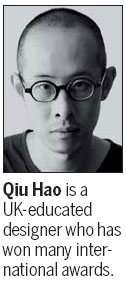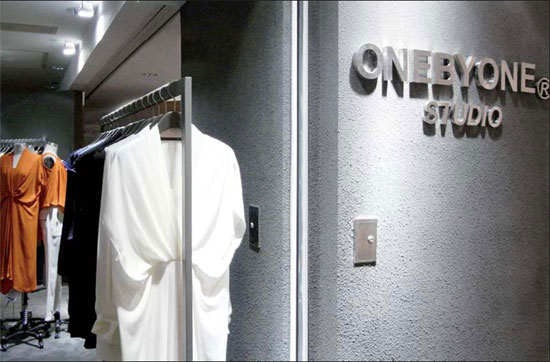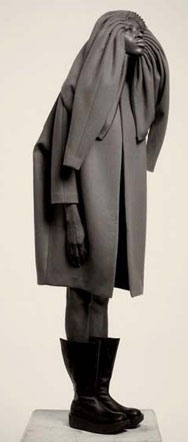Original designs on the road
Updated: 2013-02-01 07:53
By Yao Jing (China Daily)
|
||||||||
|
Shanghai's Changle Road is the birthplace of One by One, a boutique store, opened by the fashion designer Qiu Hao. Photos provided to China Daily |
How shanghai's independent fashion scene was started by a man in black with a white shop
It was just a little whitewashed shop without a sign that opened only in the evening, but 290 Changle Road was where it all started almost 10 years ago.
Then, the fledgling fashion designer Qiu Hao's boutique, One by One, was the pioneer in what, along with neighboring Jinxian Road, was to become Shanghai's "Carnaby Street".
In 2003, Qiu ambitiously intended setting up in a department store or a shopping mall, but the rents were too high and the owners were more interested in mass consumer products.
"Since we could not understand each other's approaches, I looked for somewhere else," says the 35-year-old designer, dressed in his trademark black, and relaxing with a lychee martini in a bar near his studio.
Instead, he and another designer, Qiao Qiao, decided the customers they were looking for were the customers who would look for them.
"Through the unique opening time, being nameless and a simply decorated store, we were looking for customers who had the same tastes as us," Qiu says.
They soon found each other among the budget shops in Changle Road not far away in the former French Concession area selling a variety of the usual export goods, and their success quickly attracted other new fashion designers.
Qiu's One by One and Qiao Qiao's Neither Nor collections would continue to prosper and spread.

In the shop's second year, the untrained Qiu was admitted to the prestigious Central Saint Martin College of Art and Design in London, to study for an MA in women's fashion. CSM is noted for producing daring young designers such as Stella McCartney, John Galliano, Alexander McQueen and Bruce Oldfield.
"My major was interior design (at college in China), but I began to make clothes before I was 15 years old as an amateur," he says.
After London, he returned to Shanghai in 2006 and opened a new store, twice the size, in Jinxian Road exclusively for his own signature label.
Ironically, following his cutting-edge experiences in London, Qiu found he had mellowed and matured.
"My former works could be named as art, not products," he says, adding that he pays more attention to comfort and practicality in a piece of clothing now than to pursuing his artistic bent.
This change in outlook and approach paid dividends, when in 2008 his knitwear collection won the Woolmark Prize during Couture Fashion Week in Paris, putting him in the Woolmark Hall of Fame along with fashion icons such as Karl Lagerfeld, Donna Karan and Giorgio Armani.
But just as he was about to fly to Paris to accept the Woolmark honor, the landlord of the Jinxian Road shop proposed to double the rent, against the terms of the four-year contract, arguing that more people were visiting the shopping road.
"I thought it was an unreasonable price rise, and I've always hated this kind of behavior," he says.
Qiu closed the shop, and also the one in Changle Road with his business partner Qiao Qiao, when the local government wanted it back for renovation.
However, they would go on to open 10 boutique stores around China.
One by One's first location outside Changle and Jinxian roads is Xintiandi Style, a trendy Shanghai shopping mall featuring luxury fashion boutiques.
Similarly, most of the designers who cut their teeth and cloth on the two roads after Qiu have now moved out to shopping malls or other chic areas in Shanghai like Xintiandi.
|
One of Qiu's designs from his 2012 autumn and winter collection. Photos provided to China Daily |
"I think the independent designers who once ran businesses on the two roads have contributed to the popularity of the roads, not that we are successes because of the roads' fame," he reminisces.
"I have not been there for a long time, however. Sometimes, I recall the days when I was braver at expressing myself, producing rougher works in the small store.
"The turnover of the Xintiandi Style shop just covers our investment and costs in the store."
But he says business in his other stores is much better, and he believes Xintiandi will become more popular as more designers set up shops.
At present, Qiu spends most of his time in designing.
"I like to do everything by myself, such as making patterns of a design or developing fabrics."
For Qiu Hao's line, there are six workers in the studio, while Qiao Qiao's team, which also manages the business side of the stores, has more than 10 people.
"My collection is more about fantasy while Qiao Qiao's (Neither Nor) caters more for the market to assure our business performance."
In Qiu Hao's line a dress costs about 4,000 yuan ($642; 478 euros), while a coat ranges from 3,000 to 20,000 yuan.
As he says on his website: "Don't ask me about inspiration. Image is a simple way of saying complicated thing."
Qiu introduces 30 styles each season. His latest work, called "Retiring from the World," is inspired by the traditional costumes of the Yi ethnic group from Southwest China.
Based on cashmere and wool, the collection presents simple lines without unnecessary embellishment. Black, white and ochre dominate.
Qiu himself always dresses in black. "It's a safe color. I do not want to spend much time thinking about how to match different colors.
"Besides, I don't buy clothes anymore, especially after we launched the menswear line last year."
In 2010 Qiu Hao was named by Forbes magazine as one of the top 25 most important people in the Chinese fashion industry. In 2011, he was nominated for the Breakthrough Designer Award at the Global Fashion Awards organized by the London-based fashion trend forecaster WGSN.
"It is much easier for us to find investors now," he says.
yaojing@chinadaily.com.cn
(China Daily 02/01/2013 page15)

 Li Na on Time cover, makes influential 100 list
Li Na on Time cover, makes influential 100 list
 FBI releases photos of 2 Boston bombings suspects
FBI releases photos of 2 Boston bombings suspects
 World's wackiest hairstyles
World's wackiest hairstyles
 Sandstorms strike Northwest China
Sandstorms strike Northwest China
 Never-seen photos of Madonna on display
Never-seen photos of Madonna on display
 H7N9 outbreak linked to waterfowl migration
H7N9 outbreak linked to waterfowl migration
 Dozens feared dead in Texas plant blast
Dozens feared dead in Texas plant blast
 Venezuelan court rules out manual votes counting
Venezuelan court rules out manual votes counting
Most Viewed
Editor's Picks

|

|

|

|

|

|
Today's Top News
Boston bombing suspect reported cornered on boat
7.0-magnitude quake hits Sichuan
Cross-talk artist helps to spread the word
'Green' awareness levels drop in Beijing
Palace Museum spruces up
First couple on Time's list of most influential
H7N9 flu transmission studied
Trading channels 'need to broaden'
US Weekly

|

|









